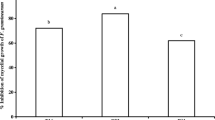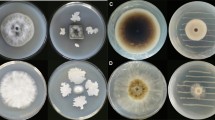Abstract
Antibiosis is assumed to be an essential mechanism exerted by potential biocontrol agents (BCAs) of Trichoderma spp. Therefore, in the present study, we report for the first time on the elucidation and production of viridiofungin A (VFA) from T. harzianum isolate T23 cultures and investigate the antifungal potential of VFA and some other secondary metabolites purified from T. harzianum cultures against Fusarium moniliforme. The bioautography assay revealed that T. harzianum isolates T16 and T23 excreted several secondary metabolites with antifungal activity. Following isolation and purification of the antifungal zones, three fractions (F223, F323 and F423) from extracts of isolate T23 and two fractions (F416 and F516) from extracts of isolate T16 exhibited pronounced fungitoxic activity in the bioautography and antibiotic disk assays against Cladosporium spp. and F. moniliforme, respectively. The structure of the antifungal metabolite in fraction F323 was identified as viridiofungin A (VFA), the first report of production of VFA by isolate T23 of T. harzianum. Following cultivation of isolate T23 in PDB medium for 9 days, 94.6 mg l−1 of VFA were determined. VFA and fraction F516 retarded the mycelial growth of F. moniliforme in the non-volatile phase assay by >90% for each 250 μg ml−1 7 days post-inoculation (dpi). While VFA and fraction F416 showed both volatile and non-volatile effects, fraction F516 seemed to exhibit mainly non-volatile activity. Microscopic examination revealed that hyphae of F. moniliforme grown on VFA-amended medium were less branched and appeared thicker than untreated hyphae. Furthermore, in the presence of VFA, formation of chlamydospores by F. moniliforme was increased. Finally, the antifungal spectrum of VFA towards various important plant pathogens was evaluated. Germination of propagules of a variety of fungal pathogens in vitro was differentially inhibited by VFA. While in the presence of 100 μg ml−1 VFA conidial germination of V. dahliae was completely inhibited, a slightly higher concentration (150 μg ml−1) of the inhibitor was required to suppress germination of Phytophthora infestans sporangia or sclerotia of Sclerotinia sclerotiorum. Contrary to several reports in the literature, VFA proved to be fungistatic rather than fungicidal. However, neither VFA nor the other Trichoderma metabolites, such as 6PAP, F416 and F516, exhibited any antibacterial activity against Gram-positive and Gram-negative bacteria.





Similar content being viewed by others
References
Almassi, F., Ghisalberti, E. L., Narbey, M. J., & Sivasithamparam, K. (1991). New antibiotics from isolates of Trichoderma harzianum. Journal of Natural Products, 54, 396–402. doi:10.1021/np50074a008.
Bailey, B. A., Bae, H., Strem, M. D., Crozier, J., Thomas, S. E., Samuels, G. J., et al. (2008). Antibiosis, mycoparasitism, and colonization success for endophytic Trichoderma isolates with biological control potential in Theobroma cacao. Biological Control, 46, 24–35. doi:10.1016/j.biocontrol.2008.01.003.
Botz, L., Nagy, S., & Kocsis, B. (2001). Detection of microbiologically active compounds. In Sz Nyiredy (Ed.), Planar chromatography, a retrospective view for the third millennium (pp. 489–516). Budapest: Springer Scientific.
Buchenauer, H. (1998). Biological control of soil-borne diseases by rhizobacteria. Journal of Plant Diseases and Protection, 105(4), 329–348.
Butt, T. M., Jackson, C., & Magan, N. (2001). Fungi as biocontrol agents: Progress, problems and potential p. 390. London: CABI Publishing.
Carpenter, J. B. (1942). A toximetric study of some eradicant fungicides. Phytopathology, 32, 845–856.
Chet, I. (1987). Trichoderma: Application, mode of action and potential as a biocontrol agent of soil borne plant pathogenic fungi. In I. Chet (Ed.), Innovative approaches to plant disease control (pp. 137–160). New York: Wiley.
Collins, R. P., & Halim, A. F. (1972). Characterization of the major aroma constituents of the fungus Trichoderma viride (Pers.). Journal of Agricultural and Food Chemistry, 20, 437–438. doi:10.1021/jf60180a010.
Cook, R. J. (1991). Twenty-five years of progress towards biological control. In D. Hornby (Ed.), Biological control of soil-borne plant pathogens (pp. 1–14). Oxon: CAB International.
Dennis, C., & Webster, J. (1971). Antagonistic properties of species groups of Trichoderma I. Production of non-volatile antibiotics. Transactions of the British Mycological Society, 57, 25–39.
El-Hasan, A., Walker, F., Schöne, J., & Buchenauer, H. (2007). Antagonistic effect of 6-pentyl-alpha-pyrone produced by Trichoderma harzianum toward Fusarium moniliforme. Journal of Plant Diseases and Protection, 114(2), 62–68.
Fravel, D. R., Connick, W. J., & Lewis, J. A. (1998). Formulation of microorganisms to control plant diseases. In H. D. Burges (Ed.), Formulation of microbial biopesticides: Beneficial microorganisms, nematodes and seed treatments (pp. 187–202). Dordrecht: Kluwer Academic.
Fujiwara, A., Okuda, T., Masuda, S., Shiomi, Y., Miyamoto, C., Sekine, Y., et al. (1982). Fermentation, isolation and characterization of isonitrile antibiotics. Agricultural and Biological Chemistry, 46, 1803–1809.
Ghisalberti, E. L., & Sivasithamparam, K. (1991). Antifungal antibiotics produced by Trichoderma spp. Soil Biology & Biochemistry, 23, 1011–1020. doi:10.1016/0038-0717(91)90036-J.
Harman, G. E. (2000). Myths and dogmas of biocontrol: Changes in perceptions derived from research on Trichoderma harzianum T-22. Plant Disease, 84(4), 377–393. doi:10.1094/PDIS.2000.84.4.377.
Harman, G. E., Howell, C. R., Viterbo, A., Chet, I., & Lorito, M. (2004). Trichoderma species-opportunistic, avirulent plant symbionts. Nature Reviews Microbiology, 2, 43–56. doi:10.1038/nrmicro797.
Harris, G. H., Turner, E. T., Meinz, M. S., Nallin-Omstead, M., Helms, G. L., Bills, G. F., et al. (1993). Isolation and structure elucidation of viridiofungins A, B and C. Tetrahedron Letters, 34(33), 5235–5238. doi:10.1016/S0040-4039(00)73961-X.
Howell, C. R. (1998). The role of antibiosis in biocontrol. In G. E. Harman, & C. P. Kubicek (Eds.), Trichoderma & Gliocladium, vol. 2 (pp. 173–184). Padstow: Taylor & Francis.
Howell, C. R. (2003). Mechanisms employed by Trichoderma species in the biological control of plant diseases: The history and evolution of current concepts. Plant Disease, 87, 4–10. doi:10.1094/PDIS.2003.87.1.4.
Howell, C. R., & Stipanovic, R. D. (1983). Gliovirin, a new antibiotic from Gliocladium virens, and its role in the biological control of Pythium ultimum. Canadian Journal of Microbiology, 29, 321–324.
Kadakal, C., Nas, S., & Ekinci, R. (2005). Ergosterol as a new quality parameter together with patulin in raw apple juice produced from decayed apples. Food Chemistry, 90(1–2), 95–100. doi:10.1016/j.foodchem.2004.03.030.
Lumsden, R. D., Lewis, J. A., & Fravel, D. R. (1995). Formulation and delivery of biocontrol agents for use against soilborne plant pathogens. In F. R. Hall, & J. W. Barry (Eds.), Biorational pest control agents: Formulation and delivery (pp. 166–182). Washington DC: American Chemical Society.
Mandal, D. N., & Chaudhuri, S. (1990). Induction of chlamydospore in Fusarium moniliforme. Indian Phytopathology, 43, 420–426.
Mandala, S. M., Thornton, R. A., Frommer, B. R., Dreikorn, S., & Kurtz, M. B. (1997). Viridiofungins, novel inhibitors of sphingolipid synthesis. The Journal of Antibiotics, 50(4), 339–343.
Manzo, S. K., & Claflin, L. E. (1984). Survival of Fusarium moniliforme hyphae and conidia in grain sorghum stalks. Plant Disease, 68, 866–867. doi:10.1094/PD-69-866.
Meinz, M. S., Pelaez, F., Omstead, M. N., Milligan, J. A., Diez, M. T., Onishi, J. C., et al. (1993). Novel squalene synthetase inhibitors. Eur. Pat. Appl. EP 526,936 (Cl. C07C235/76). Chemical Abstracts, 118, 183428t.
Metcalf, D. D., & Wilson, C. R. (2001). The process of antagonism of Sclerotium cepivorum in white rot affected onion roots by Trichoderma koningii. Plant Pathology, 50, 249–257. doi:10.1046/j.1365-3059.2001.00549.x.
Moffatt, J. S., Bu’Lock, J. D., & Yuen, T. H. (1969). Viridiol, a steroid-like product from Trichoderma viride. Journal of the Chemical Society. Chemical Communications, 14, 839.
Nakayama, H., Izuta, M., Nakayama, N., Arisawa, M., & Aoki, Y. (2000). Depletion of the squalene synthase (ERG9) gene does not impair growth of Candida glabrata in mice. Antimicrobial Agents and Chemotherapy, 44, 2411–2418. doi:10.1128/AAC.44.9.2411-2418.2000.
Onishi, J. C., Milligan, J. A., Basilio, A., Bergstrom, J., Curotto, J., Huang, L., et al. (1997). Antimicrobial activity of viridiofungins. The Journal of Antibiotics, 50(4), 334–338.
Pedersen, E. A., Reddy, M. S., & Chakravarty, P. (1999). Effect of three species of bacteria on damping-off, root rot development, and ectomycorrhizal colonization of lodgepole pine and white spruce seedlings. Forest Pathology, 29(2), 123–134. doi:10.1046/j.1439-0329.1999.00146.x.
Reino, J. L., Guerrero, R. F., Hernández-Galán, R., & Collado, I. G. (2008). Secondary metabolites from species of the biocontrol agent Trichoderma. Phytochemistry Reviews, 7, 89–123. doi:10.1007/s11101-006-9032–2.
Sholberg, P. L., Bedford, K. E., Haag, P., & Randall, P. (2001). Survey of Erwinia amylovora isolates from British Columbia for resistance to bactericides and virulence on apple. Canadian Journal of Plant Pathology, 23(1), 60–67.
Venkat Ram, C. S. (1952). Soil bacteria and chlamydospore formation in Fusarium solani. Nature, 170(4334), 889. doi:10.1038/170889a0.
Verma, M., Brar, S. K., Tyagi, R. D., Surampalli, R. Y., & Valéro, J. R. (2007). Antagonistic fungi, Trichoderma spp. Panoply of biological control. Biochemical Engineering Journal, 37, 1–20. doi:10.1016/j.bej.2007.05.012.
Vey, A., Hoagland, R. E., & Butt, T. M. (2001). Toxic metabolites of fungal biocontrol agents. In T. M. Butt, C. Jackson, & N. Magan (Eds.), Fungi as biocontrol agents: Progress, problems and potential (pp. 311–346). Bristol: CAB International.
Weindling, R. (1932). Trichoderma lignorum as a parasite of other soil fungi. Phytopathology, 22, 837–845.
Wittinghofer, A., & Waldmann, H. (2000). Ras—A molecular switch involved in tumor formation. Angewandte Chemie International Edition, 39, 4192–4214. doi:10.1002/1521-3773(20001201)39:23<4192::AID-ANIE4192>3.0.CO;2-Y.
Yedidia, I., Srivastva, A. K., Kapulnik, Y., & Chet, I. (2001). Effect of Trichoderma harzianum on microelement concentrations and increased growth of cucumber plants. Plant and Soil, 235, 235–242. doi:10.1023/A:1011990013955.
Acknowledgements
We gratefully acknowledge all colleagues for their helpful assistance in the chemical analysis and identification of viridiofungin A.
Author information
Authors and Affiliations
Corresponding author
Rights and permissions
About this article
Cite this article
El-Hasan, A., Walker, F., Schöne, J. et al. Detection of viridiofungin A and other antifungal metabolites excreted by Trichoderma harzianum active against different plant pathogens. Eur J Plant Pathol 124, 457–470 (2009). https://doi.org/10.1007/s10658-009-9433-3
Received:
Accepted:
Published:
Issue Date:
DOI: https://doi.org/10.1007/s10658-009-9433-3




